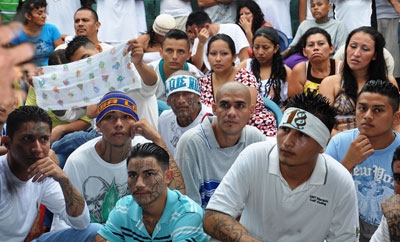The tenuous “gang truce” in El Salvador, in place since March 2012, does not fit into a classic model of peace negotiations between armed groups. Even so, any negotiation involving armed groups to try to reduce or end violence invariably raises questions that apply to most peace processes — about strategy, tactics, risks, and legal frameworks.
In the case of El Salvador, there is a conspicuous absence in the discussion: the question of women’s participation in the process — despite the fact that the importance of including women is one of the key lessons from other peace processes in the past two decades.
This article originally appeared on the Inter-American Development Bank’s blog Sin Miedos. See original article here.
In El Salvador, there are no women among the gang leaders or spokespeople, and none in public roles with the government, the mediators, or the “technical committee” meant to support the process. What’s more, few critical assessments of the truce have raised this absence as a concern.
It’s not that women have no stake in the situation: though women are a minority of gang members, they are active perpetrators and victims of gang violence. Many women in affected communities — most of whom are not gang members — are the mothers, wives, girlfriends, and sisters of gang members. They visit their relatives in prison, witnessing the overcrowded conditions, bringing food and clothing, and are the primary support system when people return to their communities after incarceration.
SEE ALSO: El Salvador’s Gang Truce: Positives and Negatives
A few years ago, relatives of incarcerated people organized peaceful protests, calling for improvements in prison conditions. But these demonstrations — which were not backed by the threat of violence — elicited little reaction. These relatives are unlikely to garner the public empathy and respect obtained by mothers protesting human rights violations against their children (such as the Madres de la Plaza de Mayo in Argentina or CoMadres in El Salvador). Even so, their experiences and grievances are relevant and may resonate differently in the public conversation than the voices of gang members themselves.
One factor in the limited success and sustainability of other peace processes is that the dialogues, negotiations, and peacebuilding and conflict resolution efforts sometimes lacked women’s voices and a gender perspective. The international community formally recognized this and called for improvements in 2000, through UN Security Council Resolution 1325. Women are still under-represented in peace processes (10 percent of negotiators and 3 percent of signatories to peace agreements are women, and only 16 percent of peace agreements refer to women), but the rationale for including women is well-established, and there is no shortage of how-to guides and toolkits. Indeed, Colombian President Juan Manuel Santos’ recent nomination of two women to the team negotiating with the FARC in Havana was widely commended — the only concern being why they weren’t included sooner.
SEE ALSO: Coverage of El Salvador gang truce
Applying the tenets of UNSCR 1325 and the “women, peace, and security agenda” to the efforts to use dialogue and negotiation to reduce gang violence in El Salvador could significantly alter the parameters of the debate and the proposals for reintegration options. Some possible implications include:
- The government would need to define more clearly who represents it, who makes decisions, and the role of mediators or intermediaries, in order to add women representatives in a meaningful way.
- Issues that disproportionately affect women may make it onto the agenda, including some that are often “invisible.” For example, sexual violence (within gangs, by gangs, or by relatives, police, or others) is often not captured in homicide data (there is often no fatality), and it’s shrouded by social stigma. Similarly, incarcerated women and women with incarcerated relatives may have specific grievances in terms of prison conditions.
- Consultation with a broader range of civil society organizations (including women’s groups) would be necessary, which could influence both the agenda for dialogue and general public opinion toward the process.
- UNSCR 1325 also calls for women’s participation in peacekeeping forces and a gender perspective in prevention and peacebuilding efforts. While there is no peacekeeping force in the El Salvador situation, this raises questions about the police force (only 10 percent of operational police are women) and the design of reintegration programs for gang-involved people.
- There is also the issue of how changes in women’s participation in gangs could challenge the traditional gender roles within the gangs.
Of course, including women in a dialogue about gang violence does not guarantee that the negotiation and proposed solutions would be more gender-sensitive or effective, nor does it resolve the larger problems related to the lack of clear strategy. Simply “adding women” is not a panacea solution to the entrenched problems of gang violence, nor to the gendered power structures within gangs and in Central American societies in general. But, given what’s been learned from other peace processes around the world, it is crucial to start asking: Where are the women in this truce?
*This article originally appeared on the Inter-American Development Bank’s blog Sin Miedos. See original article here.

